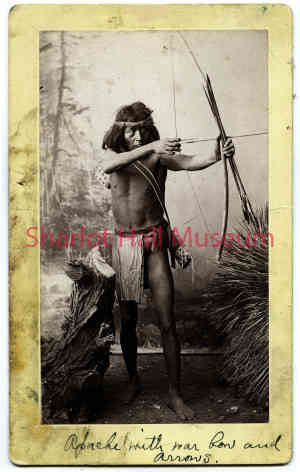Apache Man with Bow & Arrow
details
Erwin Baer Unknown ina105pb.jpg IN-A-105 Sepia 1500-0105-0002 ina105pb Photo Card Print 5x7 Historic Photographs 1880s Reproduction requires permission. Digital images property of SHM Library & ArchivesDescription
An unidentified Apache man posing with a bow and arrow in a photography studio. Although many Apaches were armed with rifles, the bow and arrow remained well-used.
Apache is a collective name given to several culturally related tribes that speak variations of the Athapascan language. The eastern most Apache group was the Kiowa from Kansas and Oklahoma. The Lipan were from New Mexico and ranged towards the Texas coast. The Jicarilla lived in northern New Mexico and southern Colorado. The Mescalero inhabited New Mexico into Texas. Farther west, in New Mexico and Arizona lived the Chiricahua. Finally, there were the western Apache which consisted of five subgroups ; the White Mountain Apache, San Carlos Apache, Cibecue Apache, Southern and Northern Tonto, all of whom resided in east central Arizona.
Early Apaches were a nomadic people, ranging over a wide area of the southwestern United States and Mexico. Because the climate was not conducive to farming, they were primarily hunter gatherers, although some practiced limited farming.
Most Apaches lived in wickiups, oval or round shelters made of brush. The wickiup’s outer covering changed with the seasons. Leafy branches were draped over it during summer and animal hides during winter to provide insulation. Because of the nomadic nature of the Apaches, these dwellings were designed to be temporary.
Most Apache clothing was made of buckskin. Women wore dresses while the men wore shirts and breechcloths, although in summer the men often went bare-chested. Both wore high leather boot type moccasins. With the introduction of commercial cloth in the 1800s, the Apache began to adopt the dress of Mexicans and Americans. Men began to wear cotton tunics and pants while women wore calico dresses.
For centuries the Apache were known as raiders and fierce warriors. Their small bands and nomadic lifestyle made it easier for them to evade capture by the U.S. Army, but eventually they were outnumbered and by 1886 the entire Apache population had been relocated to reservations.
Today, there are three Apache Reservations in Arizona. San Carlos, Fort Apache and Tonto.
Source: Book - "The Apache" by Michael E. Melody
Purchase
To purchase this image please click on the NOTIFY US button and we will contact you with details
The process for online purchase of usage rights to this digital image is under development. To order this image, CLICK HERE to send an email request for details. Refer to the ‘Usage Terms & Conditions’ page for specific information. A signed “Permission for Use” contract must be completed and returned. Written permission from Sharlot Hall Museum is required to publish, display, or reproduce in any form whatsoever, including all types of electronic media including, but not limited to online sources, websites, Facebook Twitter, or eBooks. Digital files of images, text, sound or audio/visual recordings, or moving images remain the property of Sharlot Hall Museum, and may not be copied, modified, redistributed, resold nor deposited with another institution. Sharlot Hall Museum reserves the right to refuse reproduction of any of its materials, and to impose such conditions as it may deem appropriate. For certain scenarios, the price for personal usage of the digital content is minimal; CLICK HERE to download the specific form for personal usage. For additional information, contact the Museum Library & Archives at 928-445-3122 ext. 14 or email: orderdesk@sharlot.org.




